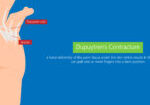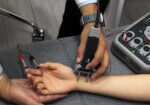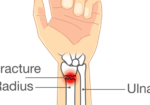Early Mobilization After Volar Locking Plate Osteosynthesis of Distal Radius Fractures in Older Patients: A Randomized Controlled Trial
Filed under Treatments
By: Rachel Reed
Sørensen, T. J., Ohrt-Nissen, S., Ardensø, K. V., Laier, G. H., & Mallet, S. K. (2020). Early Mobilization After Volar Locking Plate Osteosynthesis of Distal Radial Fractures in Older Patients-A Randomized Controlled Trial. The Journal of hand surgery, S0363-5023(20)30276-8. Advance online publication. https://doi.org/10.1016/j.jhsa.2020.05.009
The Skinny:
The purpose of this randomized controlled trial was to determine if early mobilization following open reduction internal fixation (ORIF) of distal radius fractures (DRFs) was more functionally beneficial for adults older than 50 years when compared to late mobilization. The authors hypothesized that patients would report higher positive outcomes with early mobilization; however, they found no significant differences between the two groups in ROM, grip strength, or DASH scores when assessed at 4 weeks, 3 months, 6 months, and 12 months after surgery.
In the Weeds:
This was a single-center randomized controlled trial (RCT) that took place over an 11-month period. The participants in this study received a volar locking plate (volar bearing plate) following a DRF (volar locking plate distal radius fracture). After surgery, they were randomly allocated to either the early mobilization (E-MOB) group or to the late mobilization (L-MOB) group. There was a total of 95 patients enrolled in this study; there were 47 patients in the E-MOB group and 48 in the L-MOB group.
The patients in the E-MOB group were provided with:
- A removable orthosis and daily exercises
- Non-weight-bearing exercises of the fingers and wrist from the first postoperative day
Patients in the L-MOB group were provided with:
- A dorsal plaster cast for 2 weeks
- After 2 weeks, a removable orthosis and exercises
The patients were assessed using range of motion (ROM), grip strength, and the Disabilities of the Arm, Shoulder, and Hand (DASH) questionnaire. Both groups improved when they were measured at 4 weeks, 3 months, 6 months, and 12 months after surgery. Additionally, there were no significant differences in DASH scores between the two groups at any point in time (P > .05).
Bringing it Home:
Because there were no significant differences in assessment measures between the two groups at any point in time, the authors concluded that early mobilization after surgery to treat distal radius fractures does not lead to improved patient-reported outcomes.
Rating:
3/5 – This study was interesting to read and had potential to inform practice guidelines. However, there were significant limitations to this study. The fact that the authors of this study defined late mobilization as immobilization lasting for only 2 weeks does not reflect the variation of late mobilization practices that are often put into practice by surgeons and doctors. Two weeks is still relatively early. In addition, the patient’s adherence to their home program was not monitored, which may have skewed data. It is also important to consider that the E-MOB group may not have had early mobilization exercises prescribed that were active enough to have a significant effect on their recovery (volar plate surgery recovery time is being reduced) when compared to the L-MOB group.
6 Comments
Leave a Comment
More To Read
Collagenase injection versus Partial fasciectomy in the treatment of Dupuytren’s contracture
Rapid Review By: Shruti Jani Title: Collagenase injection versus partial fasciectomy in the treatment of Dupuytren’s contracture Reference: Tay, T. K. W., Tien, H., & Lim, E. Y. L. (2015). Comparison between Collagenase Injection and Partial Fasciectomy in the Treatment of Dupuytren’s Contracture. Hand Surgery, 20(3), 386-390. https://doi-org.mwu.idm.oclc.org/10.1142/S0218810415500288 The Skinny: “Comparison between Collagenase Injection and…
Read More“Do joint mobilizations assist in the recovery of lateral elbow tendinopathy? A systematic review and meta-analysis”
By Sophia Grimm Lucado, A. M., Dale, R. B., Vincent, J., & Day, J. M. (2019). Do joint mobilizations assist in the recovery of lateral elbow tendinopathy? A systematic review and meta-analysis. Journal of hand therapy : official journal of the American Society of Hand Therapists, 32(2), 262–276.e1. https://doi.org/10.1016/j.jht.2018.01.010 The Skinny: The purpose of this study was…
Read MoreDo you know the difference between an Electromyography (EMG) and a Nerve Conduction Velocity (NCV) Study?
Do you know the difference between EMG and NCV (an Electromyography and a Nerve Conduction Velocity Study? The term nerve test is usually a broad term that typically indicates both an Electromyography (EMG) and a Nerve Conduction Velocity (NCV) study (EMG vs NCV). An EMG looks at the electrical signals your muscle makes when at…
Read MoreIs therapy needed after a distal radius fracture?
Coughlin T, Norrish AR, Scammell BE, Matthews PA, Nightingale J, Ollivere BJ. Comparison of rehabilitation interventions in nonoperatively treated distal radius fractures: a randomized controlled trial of effectiveness. Bone Joint J. 2021Jun;103-B(6):1033-1039. doi: 10.1302/0301-620X.103B.BJJ-2020-2026.R1.Epub 2021 Apr 30. PMID: 33926211. The Skinny: Individuals with distal radius fractures are very common in the hand therapy world. This…
Read MoreSign-up to Get Updates Straight to Your Inbox!
Sign up with us and we will send you regular blog posts on everything hand therapy, notices every time we upload new videos and tutorials, along with handout, protocols, and other useful information.







Early Mobilization definitely matters.
Getting the intrinsics to glide early makes life easier for the patient once they begin formal treatment
Great point.
Agree. I have seen cast put on improperly and there’s no intrinsic movement resulting in a lot of stiffness for the patient. I think it Has to be assessed on an individual basis. I think the bottom line is the patient should be seen by OT immediately to assess what they need to provide a good outcome
Yes, that is the ideal situation. For various reason this does not always happen!
What about starting at 4 weeks ? We get patients at 4 weeks often and I feel it’s a long rehab. Hand and wrist are stuff because they are told not to move until seeing a therapist .
Yes that is very late and does make for a long process.